Building, referred to as the Zootomicum, where the Department of the Animal Anatomy, Museum and Prosectorium of the University of Lithuania, Faculty of Medicine, Veterinary Department operated, circa 1925.
The History of the Veterinary Department, Faculty of Medicine, University of Lithuania in 1922–1929
In 1918 The head of the Veterinary Division (later – the Department) under the Ministry of Agriculture and State Property (later – the Ministry of Agriculture), Veterinarian E. Nonevičius, was the first to mention the necessity of establishing a higher veterinary school in Lithuania in the draft statute of the division. This was also supported in the 1920s by the participants at the Congress of Lithuanian Veterinarians. In 1921 at the meeting of the Veterinary Inspectorate (the so-called Veterinary Department) it was decided to request the Government to establish the Faculty of Veterinary Medicine. The Veterinary Department was opened at the Faculty of Medicine of the University of Lithuania and started training veterinarians. The establishment of the department was an important historical event that had a significant impact on the progress of veterinary medicine in Lithuania.
The rules of the Faculty of Medicine and the scientific plans of the departments and the posts of the Veterinary Division were approved. Duration of study – 8 semesters. 41 students and 11 free listeners were admitted in the first year to study veterinary medicine, and 8 students and 1 free listener were admitted to the third semester. Admitted students were subject to the same conditions as the students of the Medical Department.
There were 6 sub-departments in the department and 11 lecturers. Introductory subjects were listened to by the students of the department together with medical students. Special subjects – animal, general and pathological anatomy, inspection of meat, surgery, surgical pathology, obstetrics, diagnostics, therapy, bacteriology, epizootiology, zootechnics, zoohygiene, horseshoeing etc. – were taught by veterinarians: Professor E. Nonevičius, one of the most famous scientists of the faculty, and Prof. L. Gogelis, who also took care of all organisational issues at the department, Assoc. Prof. Z. Mockus, Acting Associate Professor P. Nastopka, Agronomist M. Kvašinas-Samarinas, Assoc. Prof. J. J. Bulota, Assistant J. Butkevičius, J. Kancleris-Drapas, Junior Assistant J. Žemaitis, K. Trumpis, Junior Laboratory Assistant V. Starostinas and others. Prof. Nonevičius established an award of 1200 Litas in his name to encourage students’ scientific activities and donated 100 Litas to this fund every month. Here the Junior Laboratory Assistant Vladimiras Starostinas learned to tie the first skeletons and began building a museum of animal anatomy. At the halfway point of the project, it featured various animal skeletons and about 100 hand-drawn educational posters.
Since its inception, the Veterinary Division has faced difficulties. There was a shortage of qualified lecturers, so professors and lecturers taught several subjects. There was a lack of facilities. In the yard of the second building of the University of Lithuania, a 70 sq. m. building was equipped with an auditorium, a museum, an office of the head of the department, and a prosectorium. Professors had set up departments and laboratories in their apartments, which they paid for themselves. The Veterinary Department did not have a clinic or polyclinic, so there was no quality practical training. The practical training of students took place in the veterinary hospitals of the Veterinary Regiment of the First Hussars of the Grand Duke of Lithuania the Grand Hetman of Lithuania Jonušas Radvila, but it was unsystematic. Lack of funds: The Ministry of Agriculture did not allocate funds for the construction of clinics and other facilities. There were few people willing to study because it was difficult to study, and the work was not well paid.
There were different opinions about the activities of the department: some members of the Lithuanian Veterinary Association suggested improving the work of the department, others – closing the department entirely. Rector of the University of Lithuania and Dean of the Faculty of Medicine Prof. Lašas offered to reorganise the department into the veterinary faculty and allocate money to build clinics. The Government did not take these suggestions into account. In 1928 The Commission of Veterinarians formed a list of shortcomings in the activities of the Veterinary Division, after which the Cabinet of Ministers decided to temporarily close the Division. The decision was unexpected for both the Physicians Union and the Veterinary Department. In 1929 all staff were made redundant.
The Veterinary Division was graduated by 16 veterinarians, almost all of whom were employed by the Veterinary Department, and this was a major support to the state. Military Officer S. Raštikis went on to study at the The Bundeswehr Command and Staff College. One graduate of the department, Veterinarian J. Avižienis was killed in line of duty in January 1930.
1928–1938 Gruzdžiai Higher School of Animal Husbandry operated in Lithuania, training veterinary paramedics.
Later, veterinary medicine studies were continued from 1936 at the newly established Veterinary Academy.
Prepared by the head of the museum of the Veterinary Academy. L. Baršauskienė.
Ona Starostinienė donated most of the exhibited photographs to the museum.
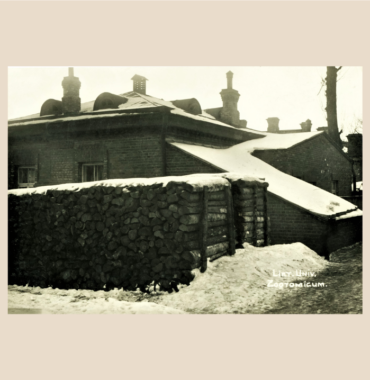
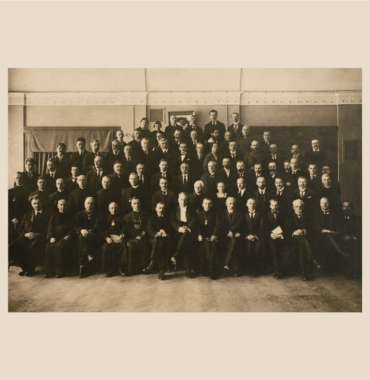
Staff of the University of Lithuania, 16th February 1923.
Amongst them – Faculty of Medicine, Veterinary Department lecturers: second row, second on the right – Assoc. Prof. Z. Mockus, fourth – professor L. Gogelis
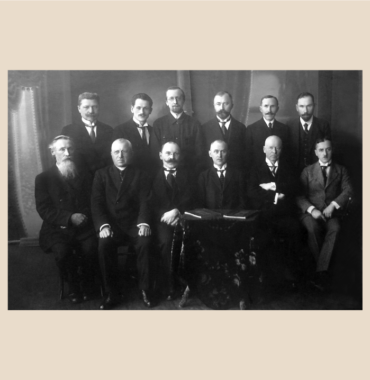
The Council of the Faculty of Medicine of the University of Lithuania, 1923.
From left: Professors – P. Raudonikis, J. Bagdonas, V. Lašas, P. Avižonis, H. Boit, J. Dzirnė.
Standing from the left: Assoc. Prof. Z. Mockus, Professors: J. Žilinskas, E. Vinteleris, P. Mažylis, A. Jurgeliūnas, L. Gogelis.
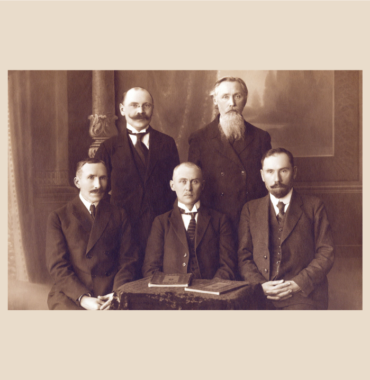
The core of the Council of the Faculty of Medicine of the University of Lithuania.
Seated from the left, professors – A. Jurgeliūnas, P. Avižonis, L. Gogelis. Standing from the left, professors – V. Lašas and P. Raudonikis.
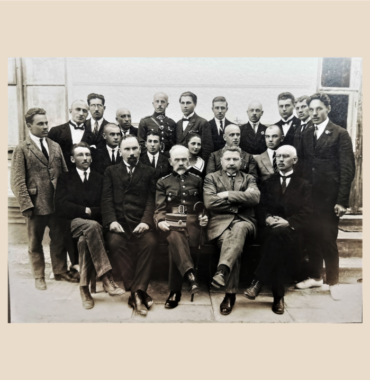
Lecturers and students of the Veterinary Department of the Faculty of Medicine of the University of Lithuania, 1925.
In the first row from the left: Assoc. Prof. N. Kvašinas-Samarinas, Prof. L. Gogelis, Military Officer Assoc. Prof. J. J. Bulota, Assoc. Prof. Z. Mockus, Prof. E. Nonevičius. Second row from the left: second – Junior Laboratory Technician V. Starostinas, fifth – military officer student S. Raštikis, Kazys Avižienis, Karolis Avižienis, Chief Assistant J. Butkevičius, Veterinarian S. Gelažius, students J. Toliušis and J. Bartkevičius.
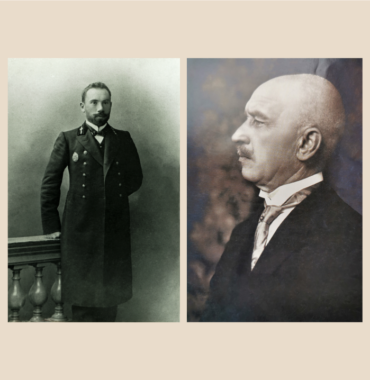
Professors of the Veterinary Department Leonas Gogelis and Elijošius Nonevičius.
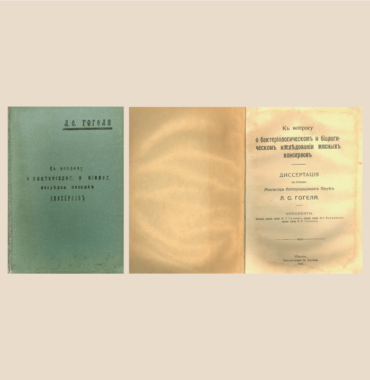
Photograph of a publication – Professor L. Gogelis’s scientific work for obtaining a master’s degree, 1916.
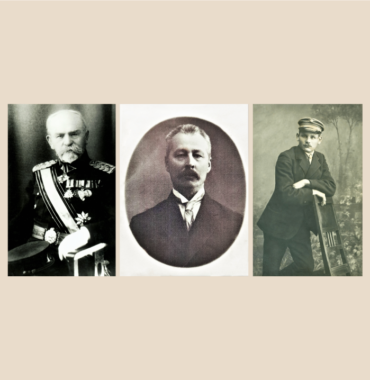
Lecturers of the Veterinary Department: Military Officer Assoc. Prof. J. J. Bulota, Assoc. Prof P. Nastopka, Senior Assistant J. Žemaitis (Rector of the Lithuanian Academy of Sciences in 1944–1947)
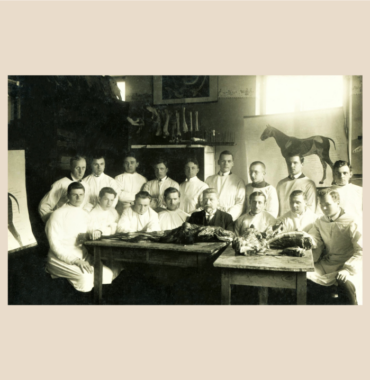
Z. Mockus, Associate Professor of the sub-Department of Animal Anatomy of the Veterinary Department (centre) with students in anatomy exercises at the Zootomicum. Next to him on the right is a young man, Laboratory Technician, V. Starostinas (Laboratory Assistant of the Department of Anatomy and Histology in 1936–1950, Assistant in 1950–1954, Associate Professor in 1954–1971).
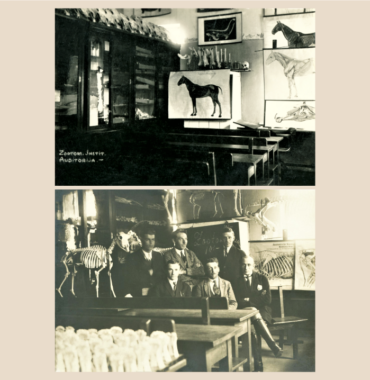
Auditorium of the Veterinary Department at the Zootomicum and the first-year students in the auditorium with the Junior Laboratory Assistant V. Starostinas (right), 1924.
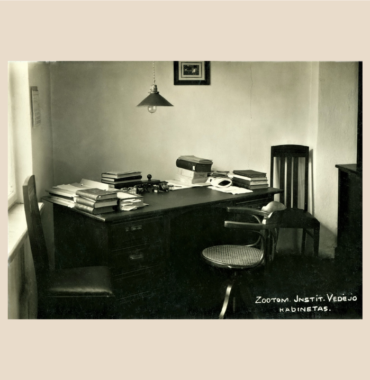
Head of the Department of Animal Anatomy Assoc. Prof. Z. Mockus’s office.
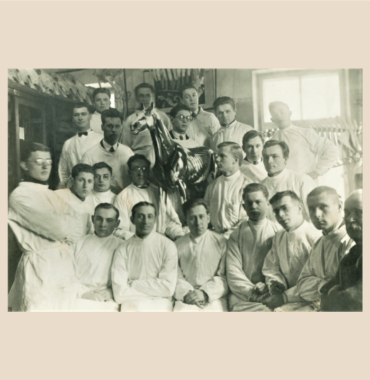
Students of the Department of Veterinary Medicine at the Zootomicum auditorium, circa 1927.
In the first-row 2nd from the left – Laboratory Assistant V. Starostinas, 4th – student A. Pabijanskas (Head of the Department of Anatomy and Histology LVA, Associate Professor 1945–1975)
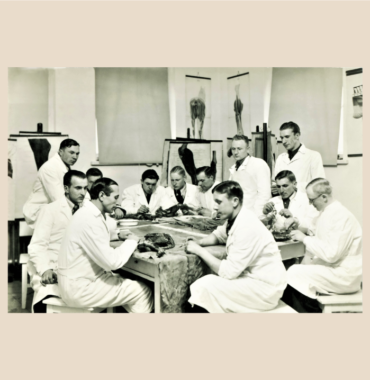
Junior Laboratory Assistant V. Starostinas of the Veterinary Department (centre) with students in anatomy exercises at the Zootomicum
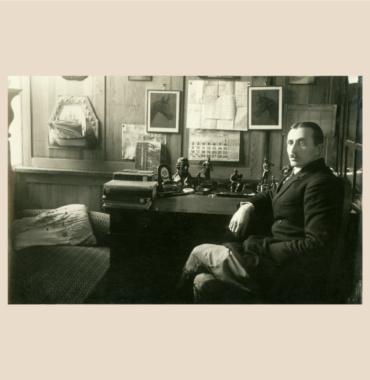
Junior Laboratory Assistant of the Veterinary Department Vladimiras Starostinas, 1927
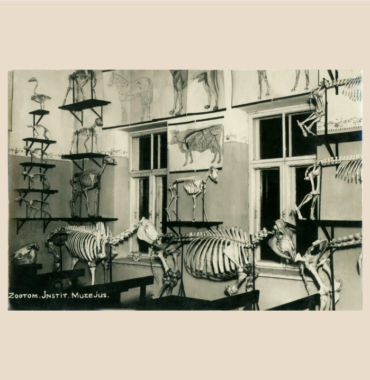
Museum of Animal Anatomy, Veterinary Department, Faculty of Medicine, University of Lithuania.
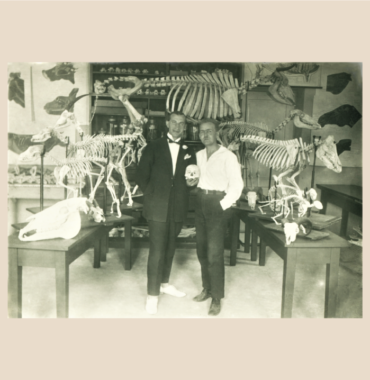
Junior Laboratory Assistant V. Starostinas of the Veterinary Department with his pet at the Museum of Animal Anatomy at the Zootomicum near a skeleton he prepared, circa 1927.
